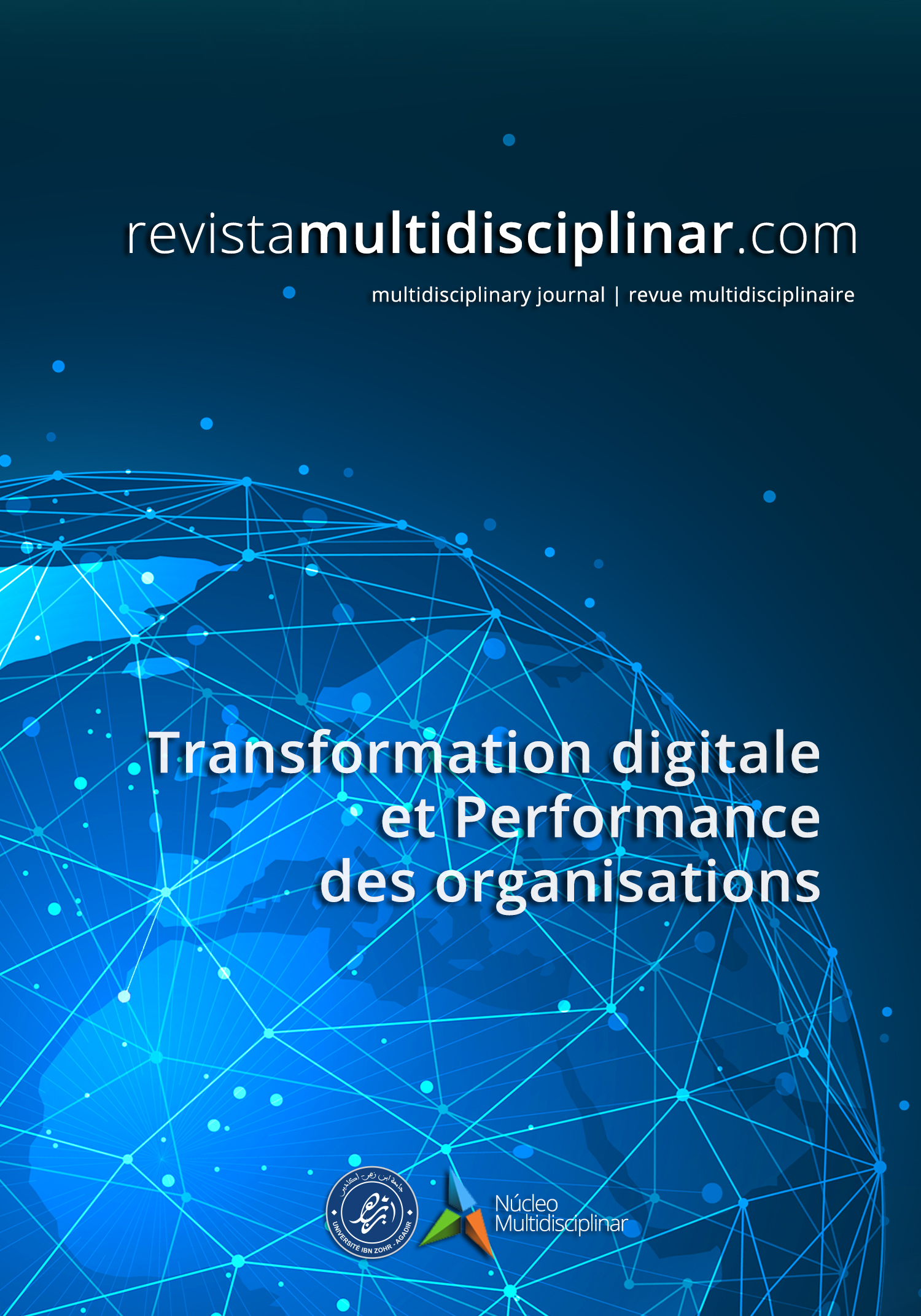Impact de l’alignement stratégique et de la culture digitale sur la réussite de la transformation digitale au sein de l’organisation publique Marocaine
DOI:
https://doi.org/10.23882/rmd.23162Keywords:
Strategic alignment, digital transformation, digital culture, information technology, strategyAbstract
Digital transformation is currently a hot topic and a strategic issue for all public and private organizations, regardless of their size. Having entered the "digital era", organizations are facing unprecedented transformations that disrupt their operations and management systems. However, the concept is new and it is not yet clear what factors influence or boost digital transformation. While previous theoretical and empirical work has allowed us to identify the impacts on the success of Digital transformation of the strategic alignment between the digital technologies implemented and the strategy of the public or private organization. Also, we have revealed that the digital culture is the guarantee of strategic coherence and success of the organization's digital transformation.
The aim of this research project is to study the extent to which digital technology deployment projects are strategically aligned with the organization's overall strategy, and the degree to which digital culture impacts digital transformation within the organization. We mobilized a quantitative method by means of a questionnaire. A total of 52 respondents from the central entities of the Caisse Nationale de Sécurité Sociale (CNSS) completed the questionnaire. These were managers and executives involved in digital transformation initiatives.
The theoretical model was tested using structural equation modeling. Analysis of the data collected using SMART PLS V4 highlights the crucial role of the CNSS establishment's strategy in value creation and the success of digital transformation. The results also indicate that to fully seize the opportunities and potential of this transformation, it is essential to embed a digital-focused organizational culture. In fine, the two hypotheses mobilized at the outset of the positive impact of strategic alignment and digital culture on the success of digital transformation are validated.
References
Amabile, B. Y. T. M. (1998). How to kill creativity. Harvard Business Review, 77–87.
Balthazard, P. A., Cooke, R. A., & Potter, R. E. (2006). Dysfunctional culture , dysfunctional organization Capturing the behavioral norms that form organizational culture and drive performance. https://doi.org/10.1108/02683940610713253
Blaize Horner Reich ; Izak Benbasat. (2000). The social factors that influence between business dimension of alignment and information. MIS Quarterly, 24(1), 81–113. https://doi.org/https://doi.org/10.2307/3250980
Boynton, A. C., Zmud, R. W., & Jacobs, G. C. (1994). The Influence of IT Management Practice Management Practice on IT Use in Large on IT Use in Large Organizations. MIS Quarterly, 18(3), 299–318. https://www.jstor.org/stable/249620
Cooper, R. B. (1994). The inertial impact of culture on IT implementation. Information & Management, 27(1), 17–31. https://doi.org/https://doi.org/10.1016/0378-7206(94)90099-X.
DELONE, William H. et MCLEAN, E. R. (2003). The DeLone and McLean Model of Information Systems Success : A Ten-Year Update. Journal of Management Information Systems, 19(4), 9–30.
Delone, W. H., & Mclean, E. R. (1992). Information Systems Success: The Quest for the Dependent Variable. Information Systems Research, 3(1), 60–95.
Deshpande, R., & Webster, F. E. (1989). Organizational Culture and Marketing : Defining the Research Agenda. 53(1), 3–15.
Fachrunnisa, O., Adhiatma, A., Lukman, N., & Majid, N. A. (2020). Towards SMEs ’ digital transformation : The role of agile leadership and strategic flexibility. Journal of Small Business Strategy, 30, 65–85.
Fimbel, E. (2007). Alignement stratégique: Synchroniser les systèmes d’information avec les trajectoires et manoeuvres des entreprises. Pearson Education France.
Gefen, D., Straub, D., & Boudreau, M.-C. (2000). Structural equation modeling and regression : guidelines for research practice structural equation modeling and regression : guidelines for research practice. Communications de l’association Pour Les Systèmes d’information, 4(1), 1–79.
Gong, C., & Ribiere, V. (2021). Developing a unified definition of digital transformation. Technovation, 102.
Henderson, J. C., & Venkatraman, H. (1999). Strategic alignment: Leveraging information technology for transforming organizations. IBM Systems Journal, 32(1), 472–484. https://doi.org/10.1147/SJ.1999.5387096
Ke, W., & Wei, K.-K. (2005). Organizational Culture and Leadership in ERP Implementation. Association for Information Systems AIS Electronic Library (AISeL), Pacific Asia Conference on Information Systems (PACIS), 428–440. http://aisel.aisnet.org/pacis2005
Luftman, J., & Brier, T. (1999). Achieving and sustaining business-IT alignment. California Management Review, 42(1), 109–122.
Luftman, J. N. (2003). Competing in the information age: Align in the sand. Oxford University Press.
Martínez-Caro, E., Cegarra-Navarro, J. G., & Alfonso-Ruiz, F. J. (2020). Digital technologies and firm performance: The role of digital organisational culture. Technological Forecasting and Social Change, 154, 1–10. https://doi.org/https://doi.org/10.1016/j.techfore.2020.119962
Moore, M. (2017). La culture des entreprises représente l ’ obstacle numéro 1 à la transformation digitale – le fossé culturel s ’ est même aggravé de 7 points en 6 ans. Rapport Du Digital Transformation Institute de Capgemini et de Brian Solis, 44(0), 4. http://www.capgemini-consulting.com/
Nwankpa, J. K., & Building, G. O. (2016). IT Capability and Digital Transformation : A Firm Performance Perspective. Thirty Seventh International Conference on Information Systems, 1–16.
Pagani, M., & Pardo, C. (2017). The impact of digital technology on relationships in a business network. Industrial Marketing Management, 67, 185–192.
Pfenning, P., & Eigner, M. (2020). A novel procedure model for developing individualized digitalization strategies. International Design Conference, 667–676. https://doi.org/https://doi.org/10.1017/dsd.2020.308
Ramakrishnan, T., Khuntia, J., Kathuria, A., & Saldanha, T. J. V. (2020). An Integrated Model of Business Intelligence & Analytics Capabilities and Organizational Performance. Communications of the Association for Information Systems, 46. https://doi.org/10.17705/1CAIS.04631
Singh, S., Sharma, M., & Dhir, S. (2021). Technology in Society Modeling the effects of digital transformation in Indian manufacturing industry. Technology in Society, 67(August), 101763. https://doi.org/10.1016/j.techsoc.2021.101763
Teece, D. J. (2018). Business models and dynamic capabilities. Long Range Planning, 51(1), 40–49.
Thietart, R.-A., & Al. (2014). Methodologie de recherche en management. In Dunod, Paris (4°édition).
Venkatraman, N., Henderson, J., & Oldach, S. (1993). Continuous Strategic Alignment : Exploiting Information Technology Capabilities for Competitive Success. European Management Journal, 11(2), 139–149. https://doi.org/10.1016/0263-2373(93)90037-i
Vivier, E., & Ducrey, V. (2019). Le guide de la transformation digitale. Eyrolles, Paris.
Downloads
Published
How to Cite
Issue
Section
License
Copyright (c) 2023 Francisco Gil

This work is licensed under a Creative Commons Attribution-NonCommercial 4.0 International License.









